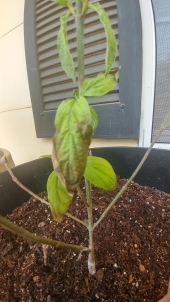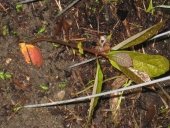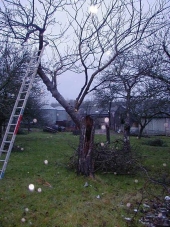




![Filename: IMG_4130.jpg
Description: [Thumbnail for IMG_4130.jpg]](/t/51407/a/33685/IMG_4130.jpg)
![Filename: IMG_4133.jpg
Description: [Thumbnail for IMG_4133.jpg]](/t/51407/a/33686/IMG_4133.jpg)
![Filename: IMG_4135.jpg
Description: [Thumbnail for IMG_4135.jpg]](/t/51407/a/33687/IMG_4135.jpg)




 1
1




Iterations are fine, we don't have to be perfect
My 2nd Location:Florida HardinessZone:10 AHS:10 GDD:8500 Rainfall:2in/mth winter, 8in/mth summer, Soil:Sand pH8 Flat








Charli Wilson wrote:Yellow leaves with green veins can indicate iron deficiency/iron chlorosis




Sometimes the answer is nothing





wayne fajkus wrote:You have access to seawater? It has every mineral that exists. Dilute 10 parts water to one part seawater. Water the tree with it. Whatever is deficient will be in there.
 .
. 2
2




Joseph Bataille wrote:
wayne fajkus wrote:You have access to seawater? It has every mineral that exists. Dilute 10 parts water to one part seawater. Water the tree with it. Whatever is deficient will be in there.
Hmmm... Never tried that for anything. Thanks for an "excuse" to make a weekend trip to the beach.

 1
1




List of Bryant RedHawk's Epic Soil Series Threads We love visitors, that's why we live in a secluded cabin deep in the woods. "Buzzard's Roost (Asnikiye Heca) Farm." Promoting permaculture to save our planet.




Sometimes the answer is nothing





 1
1




wayne fajkus wrote:With all the regenerative abilities of earth, the ocean is the one that stumps me. It accumulates minerals constantly but never gives it back, at the expense of mineral depletion upland. So putting it back makes sense. For the earth to do it for us, we'd be looking at animals 2x2 loaded in an ark.








Bryant RedHawk wrote:Sea minerals are wonderful for plants. The 10:1 ratio works very well for trees, veggies and shrubs.
Commonly, many people veer away from salt water use for plants but 30 years of research shows it is not as detrimental as common thought patterns think.
Sea-90 is sea salt with all the minerals, this has been applied to fields at the rate of 2.5 tons per acre for three years and the only thing that happened is that the plants grown grew better, were far healthier and tasted better than the control fields crops.
I use this stuff on all my fruit trees and my squash and tomatoes, it only takes about 1/2 cup for a tree (per year) and I use a table spoon for each vegetable plant, just sprinkle it around the drip line.
I also use it as the source for free choice minerals for our guinea hogs, dogs, chooks and as we get more animals, they too will have a free choice bin of sea-90.
It works great in our salt grinder on the dinner table too.
By the way, I'm not a distributor, just a user of the product.
I don't think it will be detrimental to our plants, so far my own experiments are all with positive results.
I use it on fig trees, pear trees, plum trees, mulberry trees, apple trees, squashes, onions, beets, and will be testing it on pumpkins and all our other veggies next spring.
It is not a "fertilizer" just a mineral supplement that we started using last year and were amazed at the results we got.
Soil testing is a recommendation since you don't want to get your soil out of balance if you can keep from it.
Community Building 2.0: ask me about drL, the rotational-mob-grazing format for human interactions.




"The rule of no realm is mine. But all worthy things that are in peril as the world now stands, these are my care. And for my part, I shall not wholly fail in my task if anything that passes through this night can still grow fairer or bear fruit and flower again in days to come. For I too am a steward. Did you not know?" Gandolf




wayne fajkus wrote:With all the regenerative abilities of earth, the ocean is the one that stumps me. It accumulates minerals constantly but never gives it back, at the expense of mineral depletion upland.








